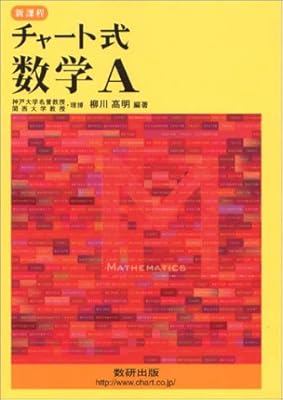
Takaaki Yanagawa (Written by)
Zuken Publishing Co., Ltd. (Publishing House)
2003April 1, 2016 (Release date)
Hardcover (Format)
今日から数学Aの総合演習問題を解いていくぞ~
まずは第1章「場合の数」だ。
ヒントを見ながら進めていく。
問1。
(1)は奇数番目が必ず奇数になるので、5Think of a permuting to pick three numbers from an odd number and a permuting to choose two from the remaining six numbers。
And then、積の法則を使って以下のように解ける。
$${ _{ 5 }{ P }_{ 3 }\times }{ _{ 6 }{ P }_{ 2 }=1800 }$$
(2)では奇数が必ず奇数番目にあるものを考える。
- 奇数が1個の場合
- 奇数が2個の場合
- 奇数が3個の場合
この3つの場合に分ける。
これらの事象は同時には起こらないので排反である。
よって和の法則を用いて、これらを足し合わせればよい。
Next up is Q2.。
これは条件から、万の位と一の位に\(0\)がくることはないとまず分かる。
またヒントを見ると、
(どれかの位が奇数になる場合の数)\(=\)(全体の場合の数)\(-\)(全ての位が偶数の場合の数)であると分かる。
In addition、偶数\(=\)偶数\(+\)偶数か、偶数\(=\)奇数\(+\)奇数である。
このようなことを考えれば解ける。
その次は問3だ。
(1)は7個の数字から4個選んで並べてできた4桁の整数について、一の位の数が千の位の数より大きいような整数の個数を求める。
千の位が\(0\)ではないことに注意して、僕は千の位が\(1\)In the case of、\(2\)の場合…と考えて解いた。
もっと簡単に、一の位と千の位は\(1\sim 6\)から2個を選び、大きい方を一の位、小さい方を千の位としてもいいらしい。
その選び方は\({ _{ 6 }{ C }_{ 2 } }\)通りだ。
あとは百と十の位を考える。
(2)も僕は(1)と同様に場合分けして解いた。
だがヒントによると、十の位が百の位より大きい整数と、百の位が十の位より大きい整数は同じ個数だけあるので、(全体の個数)\(\div 2\)としても求められるらしい。
そういうものなのかね?
(3)はヒントによると、\(5310\)より大きい整数ということで、\(531□ \)、\(532□ \)、\(534□ \)、\(536□ \)、\(54□□ \)、\(56□□\)、\(6□□□\)の場合をそれぞれ考えればよい。
さらに問4。
(1)And(2)は組合せを考えればよく、簡単だ。
(3)を僕は間違えてしまった。
2つの頂点が正十角形\(A\)の頂点で、他の1つが対角線の交点である三角形については、(2)の四角形を考えればいいらしい。
この四角形1つから求める三角形が4つできる。
The rest(2)で求めた四角形の個数をかければいい。
これはなかなか気づかないな~。
最後に問5。
ヒントによると、一筆書きをするとき、奇点(経路が奇数個集まっている点)を含む場合、出発点は奇点の一方で、終点は他方の奇点であるという。
なので今の場合、書き始める位置は2通りだ。
あとは輪っかをどの順序で描くか、輪っかを右回りと左回りのどちらで描くかを考慮して答えが求められる。
答えである一筆書きの仕方の総数が意外と多いのが印象的だった。
まぁ僕はこの問題も間違えたんですけどね。
今日はここまで。
また次回進めていこう。
Related Posts
- Chart Formula Mathematics 1 part14 [Shapes and Weighing] Toshikazu Sunada (Written by) Zuken Publishing Co., Ltd. (Publishing House) 2003April 1, 2016 (Release date) Hardcover (Format) 今日も解いていくぞ~。 問43からだ。 Now、\(\left( b+c \right) :\left( c+a \right) :\left( a+b \right) =4:5:6\)であるという。 ヒントにしたがって、\(\left( b+c \right) =4k\)、\(\left( c+a \right) =5k\)、\(\left( a+b \right) =6k\)(\(k>0\))とおく。 そしてこの連立方程式を解くと\(a\)、\(b\)、\(c\)が\(k\)represented by。 あとは\(\triangle ABC\)について正弦定理と余弦定理を使うと答えが求められる。 次は問44。 余弦定理と面積を求める公式を使えばいい。 これは簡単だ。 その次は問45。 これも正弦定理や余弦定理、面積の公式を用いて解いていけばいい。 円に内接する四角形の対角をたすと\(180°\)になることに注意だな。 まぁ簡単。 そして問46。 四角錐についての問題だ。 実際に図を描いてみて、断面で切って平面図形を取り出して解くことになる。 僕は余弦定理、面積の公式を使って解いた。 Also、三角錐の体積は\(底面積\times 高さ\times \frac { 1 }{ 3 } \)であることなどを思い出した。 念のため、三角形の相似条件を復習のためまとめておく。 三角形の相似条件は 3組の辺の比が全て等しい 2組の辺の比とその間の角がそれぞれ等しい 2組の角がそれぞれ等しい である。 一般的に平面図形(立体)が相似である場合、 対応する線分の長さの比はすべて等しい 対応する角の大きさはすべて等しい ということが成り立つらしい。 最後に問47。 相似比が\(m:n\)である図形の面積の比は\({ m }^{ 2 }:{ n }^{ 2 }\)、相似比が\(m:n\)である立体の体積の比は\({ m }^{ 3 }:{ n }^{ 3 }\)They are。 また三角柱の体積は\(底面積\times 高さ \)They are。 これらから(1)は求められる。 次は(2)But、これを僕は間違ってしまった。 四角柱を半分に切って三角柱を作って…みたいな計算をしたのだが、これではうまくいかないんだな。 体積が半分とは限らないみたいだ。 線分ADの延長と線分BGの延長の交点をIなどとして、三角錐I-ABC、三角錐I-DGH、三角錐A-DGHに着目すればいいとのことだ。 そういう風に解くのか~。 これで総合演習のA問題が終わった。 次回からB問題を解いていこう。 難しくなるかな?
- (>_ Wikipedia (The free encyclopedia)The early Showa era (Date) うわごとのとなり赤マントは復活するか 現代の怪談ばなし - Folk room - And I was a long time ago. | フジパンシステム創成学科とは | 東京大学工学部システム創成学科 魔都東京。未解決事件おばけがやって来る。
- Chart Formula Mathematics A Part4 [Number of Cases] Takaaki Yanagawa (Written by) Zuken Publishing Co., Ltd. (Publishing House) 2003April 1, 2016 (Release date) Hardcover (Format) today also solve the problem of the number of cases。 First of all, question 15。 I solved it as follows。 At first、If it rotates and overlaps, it is also a different shape.、How to paint everything is ({ 2 }^{ 9 }=512\)通りある。 また回転しても形が変わらない塗り分け方を数えると8通りある。 In addition、回転したら形が2つになる塗り分け方は12通りある。 残りは回転したら形が4つになる塗り分け方である。 よってその塗り分け方は、 $$\frac { 512-\left( 8+2\times 12 \right) }{ 4 } =120$$ 通りである。 これらから、求める答えは $$8+12+120=140$$ 通りだ。 しかしこのやり方だと、回転したとき形が2つになる塗り分け方を数えるのが分かりにくい。 数えもれが出てしまう可能性が大だ。 解答例では9マスを中央の正方形と周りの4つの長方形に分けて計算していた。 長方形の塗り方は4通りで、この中から周りの4つの長方形がの塗り分け方が 1種類のとき 2種類のとき 3種類のとき 4種類のとき を場合分けして考えればいいという。 そういうものか~ 次は問16。 (1)、(2)は\(a=6\)なので南北方向の敷き詰め方は決まる。 あとは東西方向の長さに着目すればいい。 (3)はヒントによると、まず辺ABに沿った部分から敷くと4通りが考えられる。 And、それらの場合の残り部分の敷き詰め方を考えればいい。 (1)、(2)のやり方も使って解いていくことになるが、僕は計算間違いをしてしまった。 なかなかミスが多くて困ったものだ。 その次は問17。 展開式の一般項は二項定理を用いて次式で表される。 $${ _{ m }{ C }_{ j } }{ \cdot _{ n }{ C }_{ k }{ x }^{ 2j+3k } }$$ あとは\({ x }^{ 6 }\)について\(2j+3k=6\)を満たす\(0\)以上の整数\(\left( j,k \right) \)を考えればいい。 そうしたら\(m\)の範囲を求めて、それぞれの\(m\)について\(n\)が存在するかを考える。 これで(1)が解けた。 (1)が分かれば(2)は簡単に解ける。 最後に問18。 (1)は背理法を使うなりして簡単に解ける。 まぁ背理法を使わなくても解けるみたいだけどな。 (2)はヒントによると以下のようにするのがポイントみたいだ。 $$\left( { 2 }^{ p-1 }-1 \right) \times…

